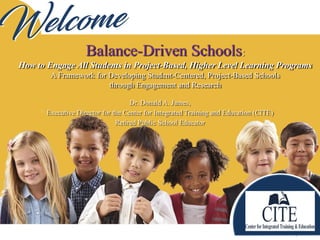
Balance-Driven Schools
- 1. Balance-Driven Schools: How to Engage All Students in Project-Based, Higher Level Learning Programs A Framework for Developing Student-Centered, Project-Based Schools through Engagement and Research Dr. Donald A. James, Executive Director for the Center for Integrated Training and Education (CITE) Retired Public School Educator
- 2. Engagement: Community Expectations Student Interests and Aspirations Staff Interests and Strengths Research: • Scholarly, Peer-Reviewed Research • Professional Sources • Action Research School Design: • Developing Balanced, Student-Centered Schools Focused on Access, Opportunity, and: • Healthy and Safe Students • Academic Success Agenda
- 3. Start with WHY! organization. A simple What Ostensibly, schools know what they do or, at least, what they are trying to do, and that is teach/foster student learning/etc. How Schools know HOW they do it. This includes their curriculum, instructional practices, assessment, SEL, and more. Why What is important is identifying WHY your school does what it does. WHY is not about implementing a new program. That is a result. WHY is about a purpose, a cause, or a belief. The very reason your school exists. principle behind
- 4. Low Wealth High ENL Low Wealth Low Performance Low Wealth High ENL High Poverty Rate High Crime
- 7. Through Engagement: Identify Areas for Review Collect Data Analyze Data Draw Conclusions Recommendations Communicate A Methodology for Creating Balanced Schools Engagement Objective: • Establish and continue the maintenance of quality relationships with as many people associated with the District and community as possible to determine expectations, interests, and aspirations for the growth of their schools.
- 8. A Methodology for Creating Balanced Schools: In Action • Supporting our Primary School Learners • Balanced Elementary School Homework: Quality over Quantity • Development of Project-Based Courses at the MS level • Developmentally-appropriate, Project-Based, College-Level Learning in a HS Through Engagement: Identify Areas for Review • Student Interest Data • Staff, Student, Parent, and Community Input • Current Educational Trends and Research Collect Data • Look for: • Themes • Trends • Generalizations Analyze Data
- 9. A Methodology for Creating Balanced Schools: In Action • Students want to learn more about positive attitudes, skills, and habits • Students want to go to college • The parents/community want opportunities for students to earn “college credit” • Students have a diverse set of interests Draw Conclusions • Develop an SEL type program that incorporates movement, arts and academics • Implement developmentally-appropriate revisions to homework guidelines • Project-based learning to meet the needs of all students • Increase project-based ‘college-level’ course offerings Recommendations and Implementation • Monitor – student performance, student participation, student interest; we gather teacher input and actively involve parents • Evaluate – determine program efficacy based on multiple measures • Communicate – State-of-the-District Reports, executive summaries, district website, district newsletters, etc. Monitor, Evaluate, and Communicate
- 10. Programs as the Result of Engagement The Elementary School “Foundation for Success” Middle School MYP and Project-Based Learning (Enrichment) Grades 9 & 10 Prepare to “try-on” College-Level Learning Grades 11 & 12 “Try-on” College Level Learning Prepared to go and to stay in college. Movement, recreation, and play that links sensory-motor, cognitive, and social-emotional experiences provide an ideal setting for brain development (Montessori). The National Association for the Education of Young Children (2009) named play as a central component in developmentally appropriate education. https://www.youtube.com/watch?v=dHIy61nQ3ak
- 11. Programs as the Result of Engagement The Elementary School “Foundation for Success” Middle School Project-Based Learning Grades 9 & 10 Prepare to “try-on” College-Level Learning Grades 11 & 12 “Try-on” College Level Learning Prepared to go and to stay in college. Students learning through PBL retain content longer and have a deeper understanding of what they are learning (Penuel & Means, 2000; Stepien, Gallagher & Workman, 1993). In specific content areas, PBL has been shown to be more effective than traditional methods for teaching math, economics, language, science, and other disciplines (Beckett & Miller, 2006; Boaler, 2002; Finkelstein et al., 2010; Greier et al., 2008; Mergendoller, Maxwell, & Bellisimo, 2006). We are all close to birds! Apply for Mini-grants Learn all about urban birds Discover a bird loving community Contribute your bird data observations National Geographic Citizen Science Projects https://education.nationalgeo graphic.org/resource/citizen-s cience-projects
- 12. Programs as the Result of Engagement The Elementary School “Foundation for Success” Middle School MYP and Project-Based Learning (Enrichment) Grades 9 & 10 Prepare to “try-on” College-Level Learning Grades 11 & 12 “Try-on” College Level Learning Prepared to go and to stay in college. The National Association of College Admission Counseling shows that colleges and universities are more interested in the rigor of the curriculum students have experienced. The top two admission facts were grades in college prep courses and the strength of the curriculum (Guskey, 2014).
- 13. Healthy and Safe Students The Why is to prepare every student for whatever they want to achieve at their next level of learning. This can be done through the development, maintenance, and enhancement of a well-balanced, educational program that supports healthy and safe students.
